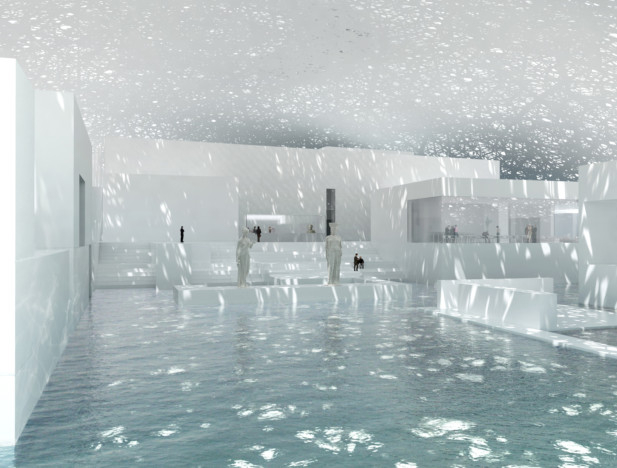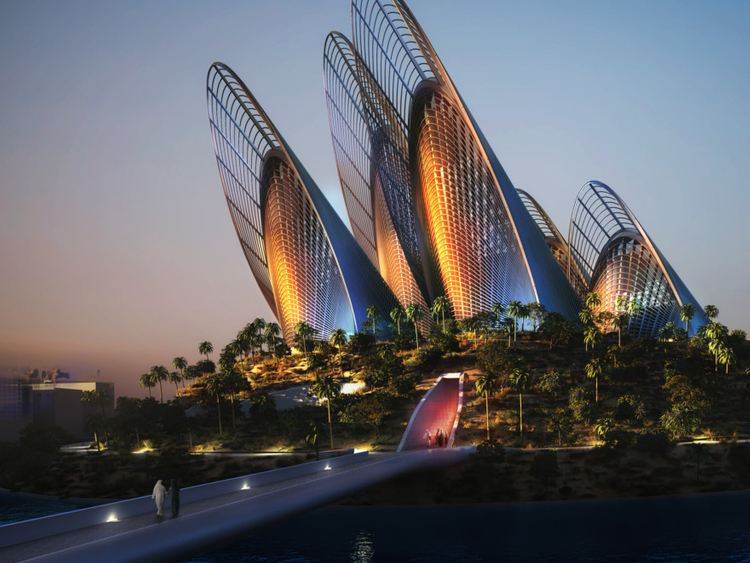Where there is quality art, there has always been architectural innovation that protects and celebrates it. Who can forget the I.M. Pei helmed extension of the Musée du Louvre, the Louvre Pyramid; Frank Lloyd Wright’s ode to Manhattan, the Solomon R. Guggenheim Museum; or the Tadao Ando designed Benesse Art Site Naoshima, the Japanese island dedicated to life’s greatest vocation.
Closer home on the Saadiyat Island, The Zayed National Museum - dedicated to the history and culture of the country – leads the charge of the future generation of architectural icons. Named after the founder of the UAE, Shaikh Zayed bin Sultan Al Nahyan and designed by Foster + Partners, the museum will celebrate Shaikh Zayed’s legacy and love of nature. Set within a landscaped garden, based on a timeline of his life, the museum is intended to serve as the centrepiece of the Island’s Cultural District. The designers’ intent to create a building that is sustainable, welcoming and culturally of its place is evident in their contemporary and extremely efficient interpretation of solar thermal towers arising from the display spaces housed within a manmade, landscaped mound. Functionally, these towers are designed to heat up and act as thermal chimneys drawing cooling air currents naturally through the museum. Designed from lightweight steel structures and sculpted aerodynamically to work like the feathers of a bird’s wing, these towers deliberately draw analogies with falcons in flight. In homage to Shaikh Zayed’s love of falconry, the museum shall also house a permanent gallery devoted to the subject as part of a wider focus on conservation – the space shall open up to an outdoor arena where these hunting birds will inhabit their natural surroundings.
With its crowning dome set in place, Louvre Abu Dhabi, the first overseas outpost of the historic French gallery steers closer to a public opening. The dome – 565.5 metres in circumference and composed of 400,000 individual elements – has been set in place over four columns. Concealed into the building these support structures belie the 7,000-tonne weight of the dome, lending architect Jean Novuel’s vision a spiritual quality as the dome appears of hover in air, over land and water.
At 320,000 square feet, the Frank Gehry-designed Guggenheim Abu Dhabi Museum is slated to be the world’s biggest Guggenheim Museum, once it’s finished.
Last month, the project’s stellar feature, and arguably its most topical exhibit, the sea, was let into the site. Flanked by the open waterscape on three sides, the Louvre Abu Dhabi’s structure is secured 10 metres below sea level, bolstered by a layered network of ¬marine piles, concrete breakwaters and -tidal pools. Light filtering in from the many ‘stars’ of the dome above will dance on the glistening liquid surface as water flows under the broad bridges that will invite visitors from the museum’s beach into the complex and surround galleries and plazas with shimmering pools.
Not waiting for its public opening, the museum has already invited the region into its treasure of art and sculpture, curating Louvre Abu Dhabi Stories. An interactive display, these series afford the museum opportunities to showcase its growing permanent collection ahead of its opening, to local and international audiences.
Investing in arts and culture lays the foundation for a shift in focus from an oil-based economy as outlined in the Abu Dhabi Economic Vision 2030. Enlisting greats such as the late Zaha Hadid whose sinuous forms inform the concept for the Performing Arts Centre, and Ando who seeks inspiration from Abu Dhabi’s natural surroundings, landscape and maritime traditions for the Maritime Museum, is a strategic decision poised to spotlight the emirate as a premier destination for innovation, arts and architecture for the global audience looking for a hit of culture.
The Infinity Mirrored Room at the Seeing Through Light exhibition at the Guggenheim Abu Dhabi.
At 320,000 square feet, Frank Gehry designed Guggenheim Abu Dhabi Museum is slated to be the world’s biggest Guggenheim Museum, once it’s finished. Tourism Development Investment Corporation (TDIC) – the government authority responsible for building the cultural institutions on Saadiyat Island – announced the finalisation of the museum’s preparatory structural works with concrete piles poured into place in 2011. At the time of its launch, Ghery called the project ‘a new invention’, layering four storeys of central core galleries around a courtyard. Two more rings of galleries will span out from the core, while a third space – designed like a raw industrial space with exposed lighting and systems – shall be reserved for larger exhibits. With 130,000 square feet of exhibition space, Guggenheim Abu Dhabi will serve the larger region with permanent collections and galleries for special exhibitions rubbing shoulders with a centre for art and technology, a children’s art education facility, archives and a state-of-the-art conservation laboratory. While the £530 million project awaits its contractor, the museum is making its presence felt. In early 2015 more than 90,000 visitors were treated to a showcase exploring the theme of light. Works by 19 international artists from the 1960s till 2015 were part of the introductory exhibit, Seeing Through Light: Selections from the Guggenheim Abu Dhabi Collection.
With an estimated cost of £18 billion, the Saadiyat Island complex is a mammoth undertaking. Architects have free reign to create never-seen-before built environments, which in itself expresses the need for experimentation in structural and construction technology. Add to that the heavy weighing decisions on appointing the right contactors and the recent economic hurdles that shook the globe – it’s not difficult to understand why these landmark projects are delayed. However, the Louvre Abu Dhabi’s sprint to completion is testament that the vision is intact and when realised, Abu Dhabi will indeed be the beacon of art and cultural innovation for the world.
— Pratyush Sarup is design manager at one of the UAE’s premium interiors firms














